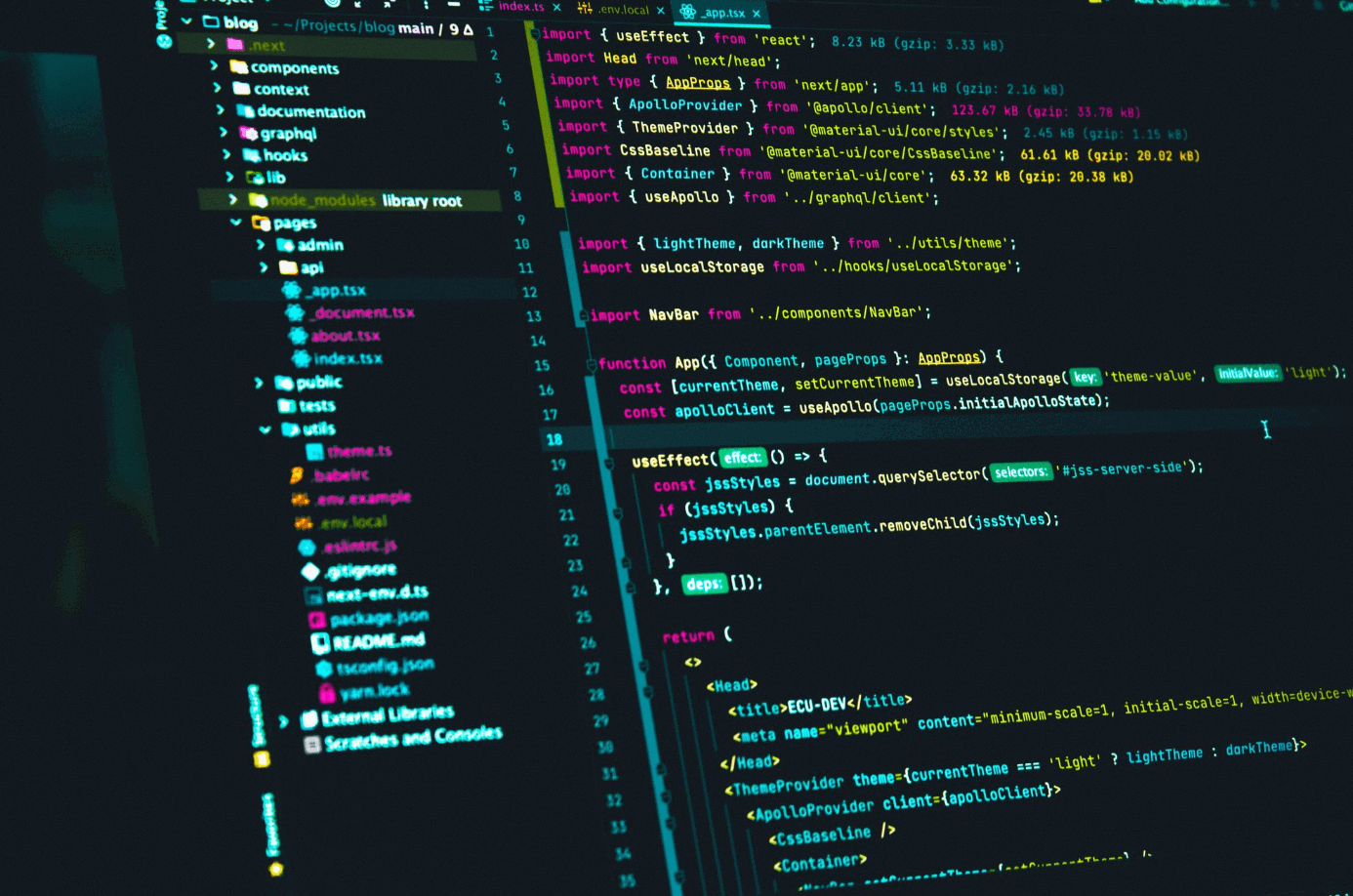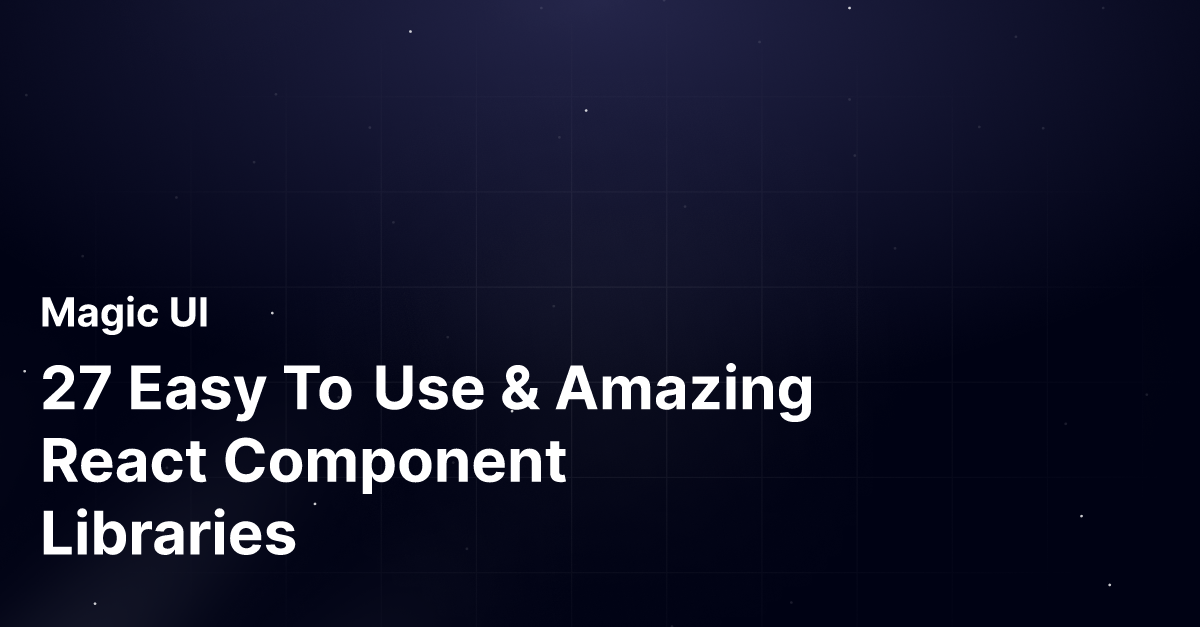Are you tired of endlessly scrolling through a mountain of UI frameworks for that perfect React component? Picture this: you have a great project idea, the perfect UI Framework in mind, and then comes the daunting task of choosing between dozens of React component libraries. If this dilemma resonates with you. Our upcoming blog will provide a detailed breakdown of React UI component libraries to simplify your search and enhance your development process.
Magic UI, a user-friendly React component library, offers an array of components and features tailored to meet your demands in the world of UI frameworks. By leveraging Magic UI, you can streamline your development process, enhance your project's aesthetic appeal, and achieve your goals of comparing React UI component libraries with ease.
What Are React UI Component Libraries?

React UI component libraries, also known as React component libraries, are software systems equipped with a range of ready-to-use components. These pre-built components are designed to be easily integrated into React-based applications and websites. By leveraging these libraries, developers can significantly boost the speed and efficiency of software development. The libraries offer many benefits to developers and businesses, enhancing the overall development process and the end-user experience.
Types of Components in React Component Libraries
The components included in a React UI component library are diverse, catering to various needs within software development. These components can range from simple elements like buttons and checkboxes to more complex ones such as tables, charts, and maps. The libraries often allow users to customize these components to align with their application's design and style preferences.
Growing Importance of React Component Libraries
The adoption of React UI component libraries has been on the rise due to the increased popularity of React-based applications across the web. Being a powerful JavaScript library, React allows developers to create dynamic and responsive user interfaces for web and mobile applications seamlessly. React is currently the second most widely used web framework globally, per the latest data from Statista. The framework empowers developers to build feature-rich, interactive web applications that continuously update their user interfaces with real-time data.
Related Reading
- React Frameworks
- What Are UI Components
- What Is A Component Library
- React Libraries
- React CSS Framework
- React Design Patterns
- React Best Practices
The Benefits Of Using A React UI Component Library

Faster Development and Time-Saving
By using a React UI component library like MagicUI, you can accelerate your development process, thanks to the pre-built components available at your disposal. These pre-existing components, including buttons, forms, and menus, are already coded for you and are ready to be utilized in your web development projects.
MagicUI's library, for instance, contains over 20 animated components, designed to help you create visually stunning interfaces without the need to start from scratch. This not only speeds up your development process significantly but also allows you to focus on building the unique, innovative features of your project.
Enhanced User Experience and Aesthetic Appeal
UI component libraries like MagicUI are renowned for their beautiful, aesthetically pleasing designs. By leveraging these libraries, developers can choose from various visually appealing components and easily integrate them into their projects. These components can be customized to match the desired look and feel of the application, ensuring that it functions well and looks great. The visually stunning and interactive elements offered by MagicUI are built using React, TypeScript, Tailwind CSS, and Framer Motion, providing developers with a powerful tool to create engaging user interfaces with minimal effort.
Cross-Browser Compatibility and Seamless Integration
One of the biggest challenges in web development is ensuring that your website or application looks and functions the same across all browsers. This is where UI component libraries shine. MagicUI, for example, offers components that are cross-browser compatible, allowing you to build applications that work seamlessly on all modern browsers.
Using a component library ensures that your application provides a consistent user experience, regardless of the browser your visitors are using. MagicUI's focus on bridging the gap between design and development empowers developers to create captivating digital experiences that work flawlessly across different browsers.
MagicUI React Component Library
MagicUI is a free and open-source UI library that we designed specifically for design engineers. It offers a collection of over 20 animated components built with React, TypeScript, Tailwind CSS, and Framer Motion. We provide a range of visually appealing and interactive elements that can be easily integrated into web applications, allowing us to create stunning user interfaces with minimal effort.
MagicUI components are highly customizable, enabling seamless adaptation to match our desired branding and design requirements. With our focus on animation and a design-centric approach, MagicUI aims to bridge the gap between design and development, empowering us to craft captivating digital experiences. Along with our free component library, with MagicUI Pro, you can save thousands of hours and create a beautiful landing page, and convert your visitors into customers with our website templates.
Use our React component library for free today at https://magicui.design/docs.
When To Use React Component Libraries

Code-first Prototyping
Component libraries are a game-changer when focusing on functionality over visual design. Rather than converting images into code, developers can easily extract the code component from the ready-made design, making prototyping with code more efficient. This allows developers to design with pre-built components without the need for any advanced design skills.
When You Lack the Skills or Experience to Build Your Own
Creating a component library from scratch may be unrealistic if your team lacks experience building reusable UI components or if you're working with tight project deadlines. In such cases, integrated component libraries offer all the code components needed for testing functionality, usability, and design before the conversion to digital products.
For Smaller Teams or Individual Designers
Financial resources need to be managed carefully for startups and small—to mid-sized companies. Leveraging open-source component libraries can be a cost-effective solution. By gradually scaling up with the help of versatile and effective component libraries, smaller businesses can position themselves for growth.
27 Top React Component Libraries

1. Magic UI - React Component Library
MagicUI is a free and open-source UI library that we designed specifically for design engineers. It offers a collection of over 20 animated components built with React, TypeScript, Tailwind CSS, and Framer Motion. We provide a range of visually appealing and interactive elements that can be easily integrated into web applications, allowing us to create stunning user interfaces with minimal effort.
MagicUI components are highly customizable, enabling seamless adaptation to match our desired branding and design requirements. With our focus on animation and a design-centric approach, MagicUI aims to bridge the gap between design and development, empowering us to craft captivating digital experiences. Along with our free component library, with MagicUI Pro, you can save thousands of hours and create a beautiful landing page, and convert your visitors into customers with our website templates.
Use our React component library for free today at https://magicui.design/docs.
2. Material UI
Material-UI (MUI) is a fully loaded UI component library offering a comprehensive set of UI tools to create and deploy new features quickly. It is one of the most powerful and popular UI component libraries out there with over 3.2 million downloads on npm a week, 78k stars on GitHub, 17k+ followers on Twitter, and 2.4k+ open-source contributors.
There are two ways to go about it: use this component library directly or bring your design system to their production-ready components. This platform will enable you to design faster without sacrificing control or flexibility. It will help you deliver excellent designs in order to delight the end-users.
3. TailwindCSS
TailwindCSS is a utility-first CSS framework designed to build modern and beautiful websites quickly. Here, utility class names define what to do. Each utility class comes with pre-defined CSS properties. To implement a CSS property, you must find the relevant class and assign it to your element. Let's say you want to make a paragraph bold on your website. You have to just assign the class font-bold to the paragraph.
Similarly, there are lots of other utility classes like underline, text-center, py-4, etc. that cover almost everything you need to do with CSS. Apart from that, Tailwind is highly customizable so if your particular use case is not met with the existing classes, you can easily create your own class to do the work. As of the time of this writing, TailwindCSS has crossed more than 78K stars on GitHub and is ruling over NPM trends with more than 8 million+ weekly downloads.
4. Chakra UI
Chakra UI, created by Segun Adebayo in 2019, emphasizes simplicity, modularity, and accessibility. The React component library Chakra UI provides developers with extensive hooks and components for constructing accessible, responsive web apps.
The large range of custom hooks that abstract away typical UI logic like animation, disclosure, and more makes Chakra UI powerful. These hooks simplify complex interfaces. Excellent offerings and performance are making Chakra UI popular with 1.3 million monthly downloads and 19,700 GitHub stars.
5. Ant Design (AntD)
If you are looking for a react-based UI component library to build enterprise-grade products, Ant Design is an excellent option. It will help you create an enjoyable yet productive work experience. This tool is used by companies like Alibaba, Baidu, Tencent, and many more. Ant Design offers multiple UI components to help enrich your application and software systems.
Ant Design also recommends you use other React-based third-party component libraries like React JSON View, React Hooks Library, and more. It does maintain documentation and supports community discussions through GitHub, Segmentfault, and Stack Overflow.
6. React Suite
React Suite is a popular React UI component library focused on building for middle platforms and backend products. It has inbuilt support for Light, Dark, and High Contrast themes that can be switched with a simple configuration.
There are more than 50 components, such as Buttons, Carousels, Calendars, Pagination, etc., in React Suite to fit your UI needs and support accessibility and i18n.
They recently did a big update that makes the code easier to understand and improves accessibility for people with different vision needs. They also added some new tools like a calendar component and fancy ways to show data loading screens. On top of that, they fixed a bunch of bugs and made it easier to control some of the components.
React Suite has amassed over 8K GitHub stars and over 97K weekly downloads on NPM.
7. Semantic UI
Semantic UI React is the official integration of the popular frontend framework Semantic UI for React. The styling of Semantic UI React is based on the Semantic UI theme and it's also free from jQuery. Apart from that, there are other useful features like augmentation, shorthand props, auto-controlled state, etc.
On top of this, there are some things you might want to consider.
- Semantic UI can feel a bit heavy for simple websites. It includes plenty of features you might not need, which can slow down your page load times.
- While customising the look and feel is possible, it can be tricky. The documentation might not always be accurate, and the code itself uses a lot of "important" styles, which can make it challenging to override it with your own styles.
- All things considered, Semantic UI is a solid option for building functional desktop web apps quickly. Just be aware of its weight and potential customization challenges before diving in. If you need a lightweight solution or a highly customized design, you might want to consider other React libraries.
The total GitHub stars of Semantic UI React are more than 13K and weekly NPM downloads are more than 230K.
8. React Bootstrap
Another popular front end framework – React Bootstrap, is rebuilt for React-based applications and systems. It has replaced Bootstrap JavaScript, where each component is developed from scratch as native React components with no need for dependencies such as jQuery. React-Bootstrap, despite being one of the earliest React libraries, has evolved to become an excellent option for building effortless user interfaces. It includes amazing UI elements for your mobile and web applications.
9. Blueprint UI
Blueprint UI, an open-source project by Palantir Technologies, provides high-quality UI components. Blueprint is a React-based UI toolkit for designing complicated, data-dense desktop interfaces. If you want to build desktop apps, this React component library is ideal. The core Blueprint NPM package includes 30+ familiar and unique React components such as Button, Card, Menu, Form Group, File Input, etc.
Blueprint's other NPM packages include Datetime and Datetime2 for dates, Icons with over 300 vector UI icons, Select and Table for selecting items in a list, and interactive spreadsheet interfaces. Blueprint UI is quite popular with 20,000+ stars on GitHub and 190,000+ weekly downloads on NPM.
10. Visx
Created by Airbnb, visa is a collection of multiple low-level, expressive visualization primitives built for React applications. It was developed to unify a complete visualization stack throughout the company, combining the delight of React with the robustness of D3 for calculations.
With visx by your side, you will get a native experience in any React-based codebase as it has the same patterns and standard APIs. This way, it solves the problems of copying-pasting various React hooks. Instead, it can abstract D3 details and offer utilities and components in standard formats. If you like customizable and performing charts, visx is a great tool.
11. PrimeReact
PrimeReact is an extensive React component library utilized by global corporations such as Mercedes, eBay, Nvidia, Intel, American Express, and Lufthansa. The app gained popularity between 2022 and 2023 (from 39.5k to 78.7k weekly downloads).
Over 90 React components are ready to use in your app. TreeSelect, Organisation chart, Terminal, and Captcha are unique components it offers. PrimeReact provides customizable templates and 280+ copy-and-paste UI elements to swiftly build any interface. Its design-agnostic infrastructure lets you use the look and feel of popular libraries like Material and Bootstrap or construct your own. The GUI-based Theme Designer includes 500+ variables to customize.
They offer help and reply to feature or enhancement requests within one business day.
12. Mantine
Mantine is a free and open-source React components library that provides 134 fully responsive React components for 25 categories, such as navbars, error pages, blog cards, comments, sliders, etc., to be produced. It’s becoming a popular choice for developers, especially those familiar with Material UI.
A Familiar Upgrade Path for Material UI Users
If you're transitioning from Material UI v5, Mantine v6 offers a smooth upgrade path thanks to their similar styling syntax (Emotion). Mantine v7 takes a different approach, relying on standard CSS for customization. Devs approve of Mantine's components for their high quality and reduced need for customization compared to Material UI. Features like multi-selects and date pickers are considered more intuitive by default in Mantine.
Modern Aesthetics and Reduced Customization Needs
Mantine also offers a modern look and feel. Unlike Material UI's distinct style with all-caps buttons and paper shadows, Mantine has a more neutral aesthetic. This allows for easier creation of unique designs without extensive customization. It has got more than 24K stars on GitHub and more than 350K weekly downloads on NPM for its core components library.
13. Fluent
Fluent is a cross-platform, open-source design tool for creating an engaging user experience. It was previously named Fabric React and is an excellent UI library created by Microsoft.
Developers and designers can benefit from its useful tools to add design elements to their applications without creating them from scratch. This powerful and intuitive tool is built to adjust according to user intent and behavior. No matter what device you use, working with Fluent feels natural, be it PCs, laptops, or tablets. Fluent is one of the best tools for creating cross-platform applications. It’s also great for other projects.
14. NextUI
Next UI is a React library that offers a collection of visually appealing pre-built components. While it stands out for its aesthetics, there's a potential downside to consider.
Some users have reported experiencing performance issues, particularly with slow loading times and freezing when changing themes on desktop. This could be a concern if a smooth user experience is critical for your project. It's also worth noting that despite the name, Next UI is not directly affiliated with the popular React framework Next.js.
It has got 19K GitHub stars and more than 100K weekly downloads on NPM.
15. Rebass
Rebass comes with a basic collection of primitive components that may be “developed” to create a best React UI component library with a standard API and design themes. Primitives for app structure (responsive boxes and flexbox layouts), text (header, text, link, button), photos, cards, and forms are all included in the foundation. Rebass also offers the finest documentation on recipes for common use cases like grids, navbar, and image cards. A ThemeProvider component is used to apply themes in Rebass. For defining theme objects and design tokens for usage with UI components, Rebass supports theme specification. Theme UI and Styled System are both compatible with Rebass. Talking about its documentation, then primitive components, theming, and design systems are some of the finest documentations of Rebass. These are responsible for providing the best React UI framework.
16. Headless UI
Tailwind Labs created headless UI as a collection of unstyled, fully accessible UI components that work seamlessly with Tailwind CSS. Headless UI provides the best React frameworks for your React project. Tailwind CSS is taken a step further with Headless UI, which provides the entire best React UI framework with the best React components.
Tailwind CSS, which is offered out-of-the-box to meet your individual needs, can be used to style them.Toggle Switch, Autocomplete, and Modal are all common components in Headless UI. Each element comes with a simple example, styling instructions for each portion, and instructions for customizing it to your needs. It also has a complete API for transitions as well as accessibility information.
17. Semantic UI React
Integrating React with Semantic UI can be an excellent strategy to get a customized UI component library for your projects. Semantic UI React helps you build your sites and applications with concise and easy HTML. It has 12k+ stars on GitHub.
With this tool, you can load any CSS theme you want on the app you are building. It also has human-friendly HTML to develop software products. It’s a declarative API that offers powerful prop validation and features.
18. React-admin
React-admin is a good option if you are looking for a React framework to build your B2B applications. It aims to provide the best experiences to developers and enables you to focus more on fulfilling your business needs.
This is an open-source tool with an MIT license. It is robust, stable, easy to learn, and a joy to work with. This is why 10,000+ companies worldwide have used React-admin on their projects. With React-admin, you can create delightful UIs, whether you are building internal tools, B2B apps, CRMs, or ERPs. It allows developers to design faster, increasing their maintainability and productivity.
19. Retool
If you are building internal applications, Retool is an excellent option. It will eliminate the struggle with UI libraries, data sources, and access controls. You will get a streamlined way of handling everything and producing apps that customers love to use.
This tool has been used by businesses of all sizes, from Fortune 500s to start-ups, to create awesome internal applications.
20. Grommet
According to its official site, Grommet is a React library that prioritizes accessibility, responsiveness, and scalability. It offers a set of pre-built components designed for building web applications that work well across different devices and for users with different needs.
User experiences with Grommet can be mixed. Some devs praise its focus on usability and theming, but others have complained about bugs and breaking changes between minor versions. While Grommet offers a good range of components, some developers find Material-UI provides a wider selection and more customization options. It has got 8K GitHub stars and more than 26K weekly downloads on NPM.
21. Evergreen
Offered by Segment, Evergreen is an amazing React UI library that helps you create delightful software products. It’s also a design system that offers flexibility and does not limit you to a particular configuration or require obsolete integration.
Evergreen facilitates building software products that can adapt to changing design needs. It offers many features, components, and benefits to help you create user-friendly and powerful interfaces. If you want to build enterprise-grade web applications, this will be a good option for you.
22. ThemeUI
Theme UI is a library for designing React user interfaces that may be customized. It mainly follows design concepts that are based on constraints. Developers use theme UI to customize base components, create themes, and create their design systems.
There are two key steps in designing using Theme UI.
- The first step is to make your theme, which requires choosing fonts and colors.
- The style of individual components is the next step, which gives you more control over your site.
Theme UI is one of the finest React libraries for web development. It allows you to style MDX content, integrates with existing styled systems and component libraries, and includes dark-mode and mobile-first responsive styles. Theme UI's extensive documentation includes instructions for theming, styling MDX, and custom hooks. Guides and recipes on using and constructing custom components are also available as resources.
23. Onsen UI
If your project prioritises a mobile-first experience, Onsen UI is a solid choice. This library helps design interfaces that feel native to mobile devices. It achieves this by offering components and features that mimic the look and feel of native iOS and Android apps. Onsen UI's touch-friendly UI and native-style animations bridge the gap between web and mobile, creating a smooth user journey for mobile users.
Naturally, there are some downsides to consider. The cost of Onsen UI has recently increased noticeably, and some users have reported bugs that take a while to get fixed. While iOS performance is good, Android apps built with Onsen UI can sometimes feel sluggish. Native functionalities like maps require separate plugins.
It has got 8K GitHub stars and more than 24K weekly downloads on NPM.
24. React Router
Developed and maintained by the Remix team and its contributors, React Router is an impressive React UI component library. Its recent version is v6 which uses the best features from its previous versions and features some improvements as well.
Development teams from reputed companies such as Airbnb, Discord, Microsoft, and Twitter have used this tool in their projects. It’s best to search for a router user interface that can work with a different interface. It can match your app components with corresponding URLs to ensure a better user experience.
25. Gestalt
Gestalt is a UI library that helps you create amazing user interfaces that people love using. It’s also Pinterest’s design tool and comes with many features and components. Its interface is also smooth to allow developers quickly get started with the tool.
26. Shards React
Web development professionals get the choice to craft an extensive range of precise dashboards, web portals, and mobile applications for a diversity of industries component libraries. The sleek and straightforward design Framework also makes it one of the best in the minimalist libraries of React components. The React library is fast and efficient on the different platforms because of the optimized code.
Shards React can ensure that developers have the perfect mixture of customization options. There are many components, and the base library is free. But if you wish to get more templates, components, and blocks, you can always purchase the pro kit to ensure the addition of tons of additional features.
27. React Motion
If you want a solution to animate components in React, you can consider React Motion. It is an excellent React library that will help you create realistic animations. It’s easy to get started with this tool and use it. This tool is even more attractive because you can specify stiffness values. You can also define damping parameters. This way, your components will look more realistic as you can control the stiffness. React Motion can easily animate a simple card component’s scaling. For this, you will need to utilize styled-components.
What Makes A Good Component Library?

Consistency and Uniformity
Maintaining consistency across all UI elements is critical. This means consistent design languages, colors, typography, and spacing across all components. Consistency helps create a cohesive user experience and streamlines the design process for designers and developers alike.
Flexibility and Customizability
A good component library has to offer flexibility. Components should be easily customizable to fit different contexts and needs without breaking the overall design coherence. Providing options for modifying colors, sizes, states, and behaviors allows for adaptability to various scenarios.
Documentation and Usage Guidelines
A comprehensive and detailed usage guideline is essential. It helps users understand how to implement and adapt components correctly. This ensures that components are used as intended, maintaining the integrity of the design system.
Accessibility
Accessibility should be a top priority. Components need to be designed and built with accessibility standards, making them usable by people with disabilities. This includes proper ARIA attributes, keyboard navigability, and sufficient color contrast.
Ease of Integration
A good component library should be easily integrated into various projects and tech stacks. This means providing well-structured code, compatibility with different frameworks, and straightforward installation processes.
Scalability
A scalable component library should accommodate new components and patterns as projects grow. Scalability ensures that the library remains relevant and useful as projects evolve over time.
Community and Support
A vibrant community and active support channels can significantly enhance a component library. When users can share experiences, provide feedback, and contribute to development, it creates a dynamic and improving resource. Responsive support can help resolve issues quickly.
Related Reading
- Best React Native UI Library
- React Component Best Practices
- Tailwind Vs Bootstrap
- Material UI Alternatives
- Best React Component Library
- React Tips
- Create React Component Library
- Cool React Components
- Component Library Examples
- Bootstrap Vs React
- React Native Libraries
- Best React UI Framework
- NextJS
- Next.JS
- Next JS
- React Bootstrap
- MUI Table
- MUI Card
- MUI Box
- What Is NextJS
How To Get The Best Out Of Using React Component Libraries

Before integrating a library into your project, take the time to understand what it excels at. For instance, Material-UI offers a comprehensive suite of UI components. You can select the best tools to address your application's specific needs by identifying each library's strengths.
Combining Libraries for Enhanced Functionality
Consider combining two or more React libraries to create a more robust development environment. Combining libraries allows you to take advantage of their collective strengths, streamlining your development process and making it more efficient and effective.
Enhancing Libraries with Magic UI
Integrating Magic UI alongside your existing libraries can be a game-changer. Magic UI enhances your libraries in several ways:
Consistency
Ensures a consistent look and feel across your application, irrespective of the libraries used.
Efficiency
Automates repetitive tasks and streamlines the integration process, saving you time and effort.
Customization
Offers advanced customization options to tailor the libraries perfectly to your specific needs.
Accessibility
Improves accessibility features across your application, providing a better user
experience for all users.
Adding Magic UI to your library stack enhances the capabilities of each library, leading to a more cohesive and powerful application.
Check Out Our React Component Library for Design Engineers
MagicUI is a free and open-source UI library that we designed specifically for design engineers. It offers a collection of over 20 animated components built with React, TypeScript, Tailwind CSS, and Framer Motion. We provide a range of visually appealing and interactive elements that can be easily integrated into web applications, allowing us to create stunning user interfaces with minimal effort.
MagicUI components are highly customizable, enabling seamless adaptation to match our desired branding and design requirements. With our focus on animation and a design-centric approach, MagicUI aims to bridge the gap between design and development, empowering us to craft captivating digital experiences. Along with our free component library, with MagicUI Pro, you can save thousands of hours and create a beautiful landing page, and convert your visitors into customers with our website templates.
Use our React component library for free today at https://magicui.design/docs.
